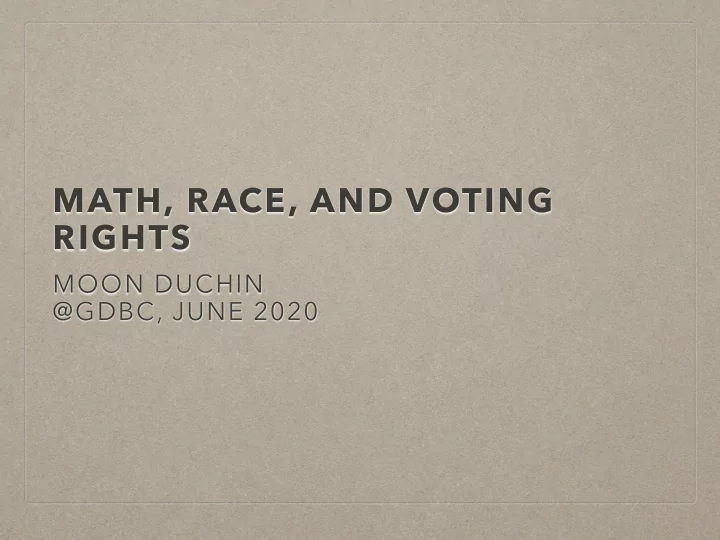

MATH, RACE, AND VOTING RIGHTS MOON DUCHIN @GDBC, JUNE 2020
WELCOME TO new name GEODATA BOOTCAMP highly welcome! It's 2020 - we're in a global pandemic, and the raised voices of many Americans over police violence against Black people have been met with fascist and militaristic response. It's a major election year, and voting itself is a battleground across the country. Voting rights work needs DATA. Let me try to set the stage for some of the work we will do together.
DIMENSIONS Data science meets civil rights • data bureaucracy : census and classification • geography : maps and spatiality • law and policy : structure/systems • math : models, metrics, assumptions, artifacts • democracy : dynamics of representation, legitimacy
GERRYMANDERING: BORDERS WITH AGENDAS Suppose there are two kinds of voters and • a first-past-the-post electoral system. In principle, 40% of the votes can secure anywhere from 0-80% of the seats. How can you identify manipulation? •
0 2 1 3
WHEN WE CREATE DISTRICTS, WE'RE CUTTING UP TERRITORY • What is a good cut? • What properties are reflected in boundaries? • What effects are produced by boundaries?
COMMUNITY MATTERS Many states have a rule to respect "communities of interest"; this is essentially never made precise What kinds of shared interests matter most for a voice in government?
FORENSICS: RACE CANNOT "PREDOMINATE" • Can you read reasons off of a map? • What is more predictive, race or party?
SPATIALITY
SPATIALITY
SPATIALITY
SPATIAL SORTING AKA CLUSTERING AKA SEGREGATION
Segregation/clustering makes it possible to draw "designer districts" to dilute the vote... ...or by the same token, districts can be drawn to enhance the voting power of a minority.
Flip side: when population is very homogeneous, the lines don't matter.
POLITICAL GEOGRAPHY 34% R 32% R We proved complete R lockout from 2000-2010 (see VRDI paper in Election Law J)
SPATIALITY MATTERS 😮 Maryland Massachusetts 36.9% R votes 28% R reps 36.7% R votes 0% R reps 1994 1994 1996 1996 1998 1998 2000 2000 2002 2002 2004 2004 2006 2006 2008 2008 2010 2010 2012 2012 2014 2014 2016 2016 2018 2018
BACK TO THE GEOGRAPHY: ONE IS "ELASTIC" AND THE OTHER IS RIGID 34% R 32% R
But data does not make itself.
COLLECTING AND PREPARING THE DATASET At our Voting Rights Data Institute 2018, we called all 88 counties in Ohio to ask the simple question, where are your precincts ? • 46 counties had shapefiles • 27 counties had PDF maps • 8 counties sent paper maps ☛ • 7 had nothing Ruth Buck, MGGG Data Wizard
RECENT PROJECT 1 - LOWELL
RECENT PROJECT 2 - CHICAGO
WE'LL TALK ABOUT MEASURING RACIAL POLARIZATION
APPLICATIONS: CITY COUNCIL
MAIN RESEARCH DIRECTION: ALTERNATIVE DISTRICTS • Physical, political geography held constant • How else could the lines have fallen?
FIND THE UNITS, MAKE A GRAPH, DIVIDE IT INTO PIECES • Otherwise known as redistricting ! • E.g., Massachusetts has 2151 precincts and these must be divided into 9, 40, and 160 districts with nearly equal population
A BASELINE FOR VOTE DILUTION
SO MANY THINGS TO WORK ON! • computational social choice • topological data analysis • disaster response • differential privacy • partisan metrics • voting rights baselines and metrics • .........
very excited to work with you this summer. mggg.org districtr.org
Recommend
More recommend